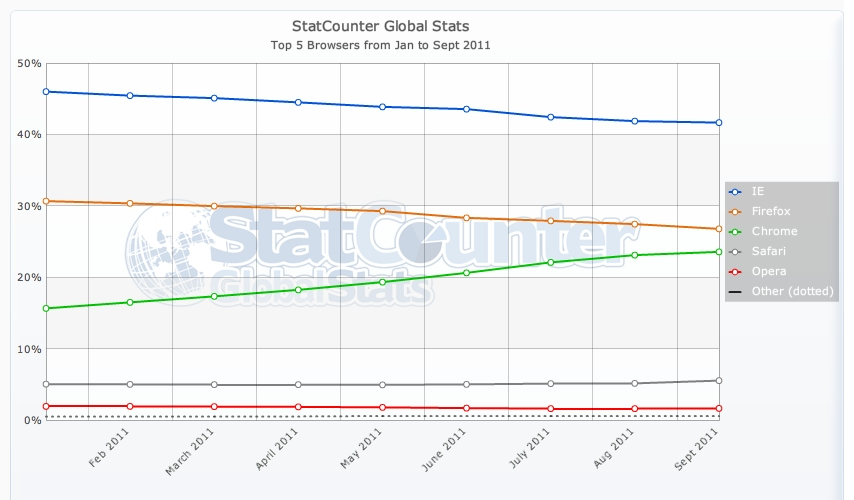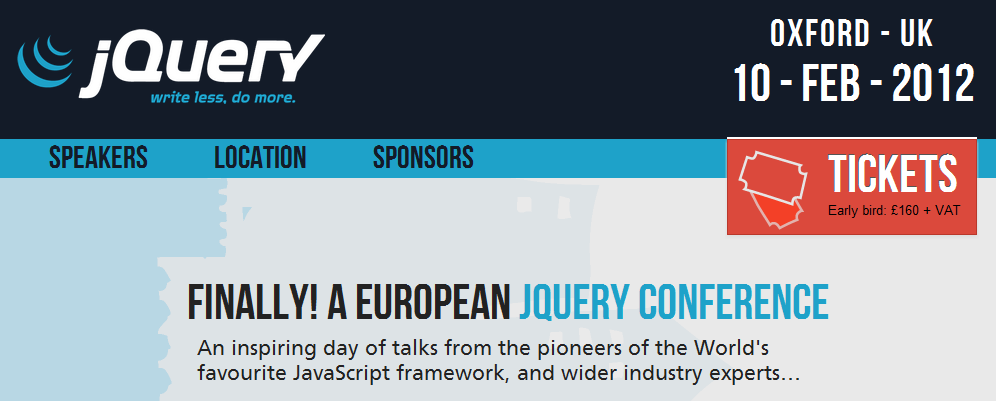Back to my desk (down under)
Well that was a quick three months! Travelling around south-east Asia was incredible! So many memories and stories to take away from the experience. Unfortunately all good things have to come to an end, so back to work it is. Actually I’ve been looking forward to getting back to work for a couple of weeks, itching to start using the latest technologies the web has to offer.
A lot can change on the web in three months; so in order to get my head around what’s new, I’ve compiled a list of exciting developments and changes in the Web Developer community (in no particular order).
Browsers
Thankfully the browser war has started again (this time for the better) and it certainly hasn’t slowed down in the last three months!
Some amazing news first; Has Internet Explorers browser market share finally dropped below 50%? Well according to Statcounter it has (oh please let it be true!). As with all statistics you have to be careful how you interpret the data. A more important statistic would be how that 50% is broken down. How many users are still using IE6? If corporations are still sticking with IE6 due to internal tools and upgrade cost, that value won’t be changing any time soon (boo!).
WebGL is the big thing on the web at the moment. Incredible graphics rendered directly in the browser (no Flash required!). Of course Microsoft being Microsoft, they aren’t going to support it. To be fair they do give a good excuse; the specification isn’t 100% set, so they aren’t going to implement it (but when has that ever stopped them before?). Luckily for developers a small team in Russia have decided to add it themselves by creating a plug-in for IE (for non-commercial use) called IEWebGL. It’s not ideal but it’s better than nothing!
There’s been big changes at Firefox over the past three months. The Firefox team have now adopted a six week release schedule just like Chrome. So while I’ve been away we’ve had version 6,7 and 8. There’s even talk of Aurora 10 (a.k.a. Firefox 10) on the horizon. Mozilla also seem to have adopted the ‘channel’ route for deployment, where by you can join the stable, beta or nightly channel depending on how brave you are. You can receive a new version of Firefox every few days (or sometimes a broken version) if you so wish. I’m hoping they also adopt the ‘delta’ update strategy that Chrome uses; no need to download the whole installer every time, only the parts that have changed. On a side note, Firefox now gets 100% on the Acid3 test, so well done to Mozilla for achieving that (if that type of browser comparison floats your boat).
I love this little addition; in the latest nightly versions of Firefox, Mozilla has added support for the draft JoystickAPI. What an incredibly simple idea, it never even occurred to me! The API allows a browser to communicate directly with a joystick / gamepad, meaning you can control that snazzy HTML5 game you’ve written just like you would on a games console. There’s a breakdown of what is supported on the API page including handy code examples. All you need is a joystick that’s supported by your PC or Mac. It looks like a standard Xbox360 controller will work, and they’re fairly cheap to buy. I May just have to add that to my Christmas list this year and give it a whirl!
With the IE browser market share (apparently) going below 50%, it looks like Chrome could be set to take number 2 spot from Firefox very soon. I must admit, I’m not too bothered about who’s in second place; as long as all browser vendors keep improving their products I’m a very happy developer. More competition equals better browsers for all. When one of the ‘good’ browsers gets to number one, then I will celebrate.
At the start of October Google unveiled their new Dart programming language which is supposed to replace JavaScript as the working language on open web platforms. Dart will compile to ECMAScript 3 on the fly for non-Dart compatible browsers. There’s even a simple IDE so you can start playing around with a bit of Dart right now. Will it catch on? Who knows, only time will tell.
Last but not least the browser that everyone forgets about (but it’s actually an excellent browser), Opera. At the start of October they released Opera 12 alpha, which finally supports WebGL! Great news for Opera and WebGL. As it looks like WebGL is here to stay, maybe it’s time the IE team reconsidered its position? Let’s hope they do.

JavaScript
The big event (in Europe at least) that happened while I was away was JSConf.eu, a 2 day conference dedicated to the JavaScript programming language. This year it was held in Berlin, Germany, somewhere I’ve never been (but have heard many great things about). I wish I could have been there, a couple of the talks I’d loved to have seen include “Magic Wand for surface generation – Voxels with JS” and “Connecting the real world to node“. Luckily for those of us who couldn’t be there videos of most of the talks are available online.
Talking of Node, the development team has been bug fixing and adding lots of lovely new features to the code base, and it is now up to version 0.6.0. A point that really caught my attention was the work regarding Windows support. Being a Windows user myself it’s always nice to know the Windows platform is being considered in future development. Looking at the performance statistics in the 0.6.0 blog post, the team have made huge improvements by supporting native APIs (rather than through Cygwin).
Note: As I was writing this blog post Node 0.6.1 was released and it now comes with a Windows installer (MSI).

jQuery
For users of jQuery (myself included) it’s been a very busy three months. There have been three new versions released (not including betas and RC’s), 1.6.3, 1.6.4 and 1.7. Here are some of the key features that caught my eye in each version:
- 1.6.3: requestAnimationFrame API has been removed for animations due to strange goings on when animated tabs are hidden from view. The team plans to re-implement it in a later version.
- 1.6.4: Minor bug fix release.
- 1.7: Big changes in the way events are bound (and unbound) to elements. There’s a whole new .on(), .off() event API which aims to unify all the ways of attaching events in jQuery. Also, as mentioned on the jQuery blog they are shorter to type!
For version 1.8 the jQuery team is planning on slimming down the library to reduce it’s overall gzipped file size. They are asking for feedback from the community as to what should be removed and offloaded into a separate plug-in, or maybe even removed all together. There are now so many methods available to a developer, a lot of which are probably never used; I can see why they are looking to slim it down. Maintaining rarely used code is never fun.
I personally would like to see the animations offloaded to a separate plug-in, as for most projects I never use them. I’d happily add the animation plug-in back in if and when needed. Maybe this could be the start of a more modular version of jQuery; by that I mean something along the lines of the MooTools core builder. Creating a custom jQuery build, with only the parts you need really would be a great option. I’m sure lots of other jQuery developers would be against it, but each to their own.
Last in the jQuery news is the announcement that there will be a jQuery conference in Oxford, UK in 2012. It’s the first jQuery conference in the UK, and of course I’m now in Australia. Typical! Oh well, maybe next time.

Three.js
The three.js community has been busy beavering away with lots of cool new demos. It’s incredible how this superb JavaScript library has taken off since mr.doob unleashed it on the web.
I’ve noticed from the Git repository for three.js that the number of updates has really slowed down. Maybe there are things in the pipe line that have yet to be rolled into the Git repository; or maybe it’s a sign of the three.js API stabilising.
One of the major problems I found while working on a few personal projects was the lack of documentation. It really was a case of diving into the library and examples and having a play (fun, but not ideal). Stability will allow the documentation to catch up with the current release, and in turn allow the wider community to develop lots more interesting 3D demos.
Speaking of interesting demos, here’s one that’s been released by HelloEnjoy called Lights – An interactive music experience. I can’t say I’ve heard of Ellie Goulding (I know, I’m old), but it’s a catchy tune and kudos to her record company for pushing the music video envelope. Is interactivity the future of music videos? I hope so!

Demos
One thing I really missed while I was away was how all this new technology is being applied on the web. It’s always interesting to see how other developers apply technology to problems they encounter. Creating demos is a fun way to learn something new.
First on the list is a bit of face detection using HTML5 and JavaScript. This technique is used in various webcam applications, where you can add things like glasses and masks to your face in real-time. Hours of fun for kids (and developers too). The demo makes use of the CCV JavaScript Face Detection library and HTML5 canvas element. Awesome stuff by @wesbos, and as a bonus there’s a whole blog post with commented code on how he did it.
What do you get when you combine Google maps and WebGL? That’s right, you get MapsGL! Google has enabled the option to view its maps complete with 3D buildings, in the browser, no plug-ins required! Superb news for WebGL as there is no bigger name you want behind you to push the technology into the mainstream. It’s still a little rough around the edges but it looks very promising! You can enable and view a demo here.
Mozilla developer Michael Bebenita has created and released a JavaScript-based H.264 decoder that will run natively in the browser… wow! Nicknamed Broadway, it is based on the open-source decoder that Google uses in the Android OS. Yet another example of how powerful the JavaScript programming language is. To test it you will need a nightly version of Firefox, or you can always view a video from Brendan Eich’s talk at ACM’s annual OOPSLA conference, where he shows it in action. Amazing!
Do you want to help a computer beat a Grandmaster at chess using JavaScript? Well now you can thanks to the Chess@home project. Developers at Joshfire created a project prototype at this years 48 hour Node Knockout contest. It utilises lots of cutting edge technologies. Starting with the Web Workers API in the browser, to Socket.io for communication and a Node.js – MongoDB combination for storing the results. It works by using the spare CPU cycles of browsing users to calculate the best next move. By adding a small Chess@home widget to your website you can help the project defeat a Grandmaster. By making use of the Web Worker API, visitors to your website won’t even notice the difference (users can disable the widget via a check box if they so wish).

As you can see the Web Development community has been busy over the past few months! Hopefully I picked out most of the important changes. If you think there’s anything I’ve missed that’s a worthy addition, please leave a comment, I’d love to hear about it.
